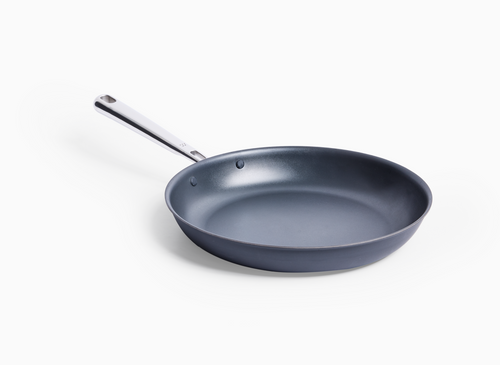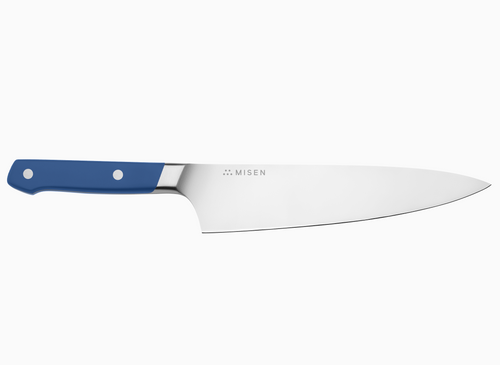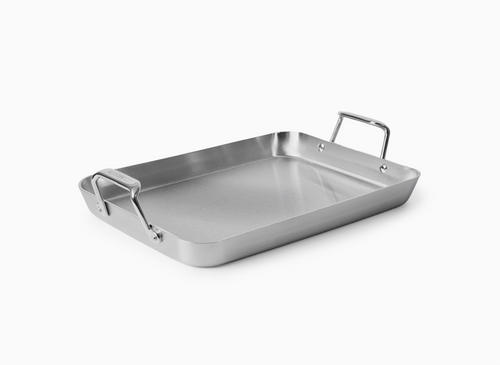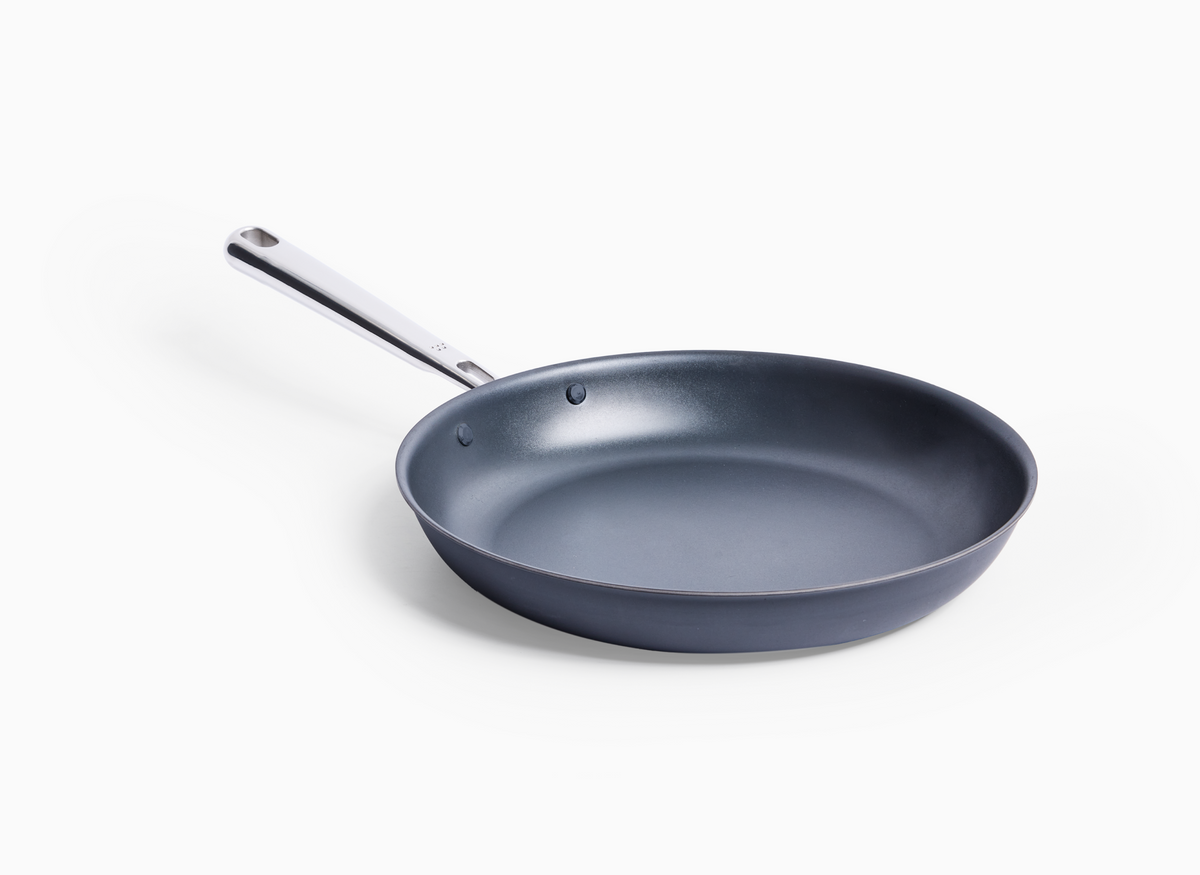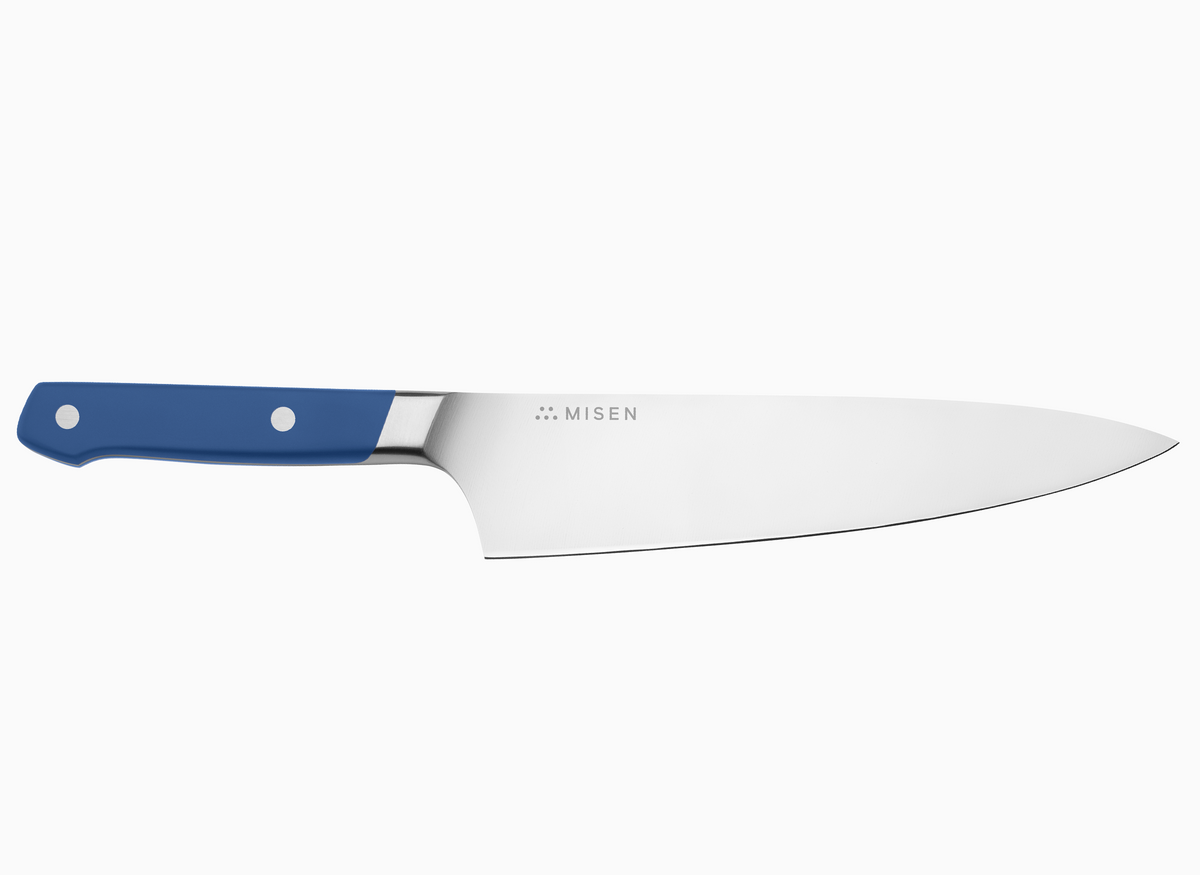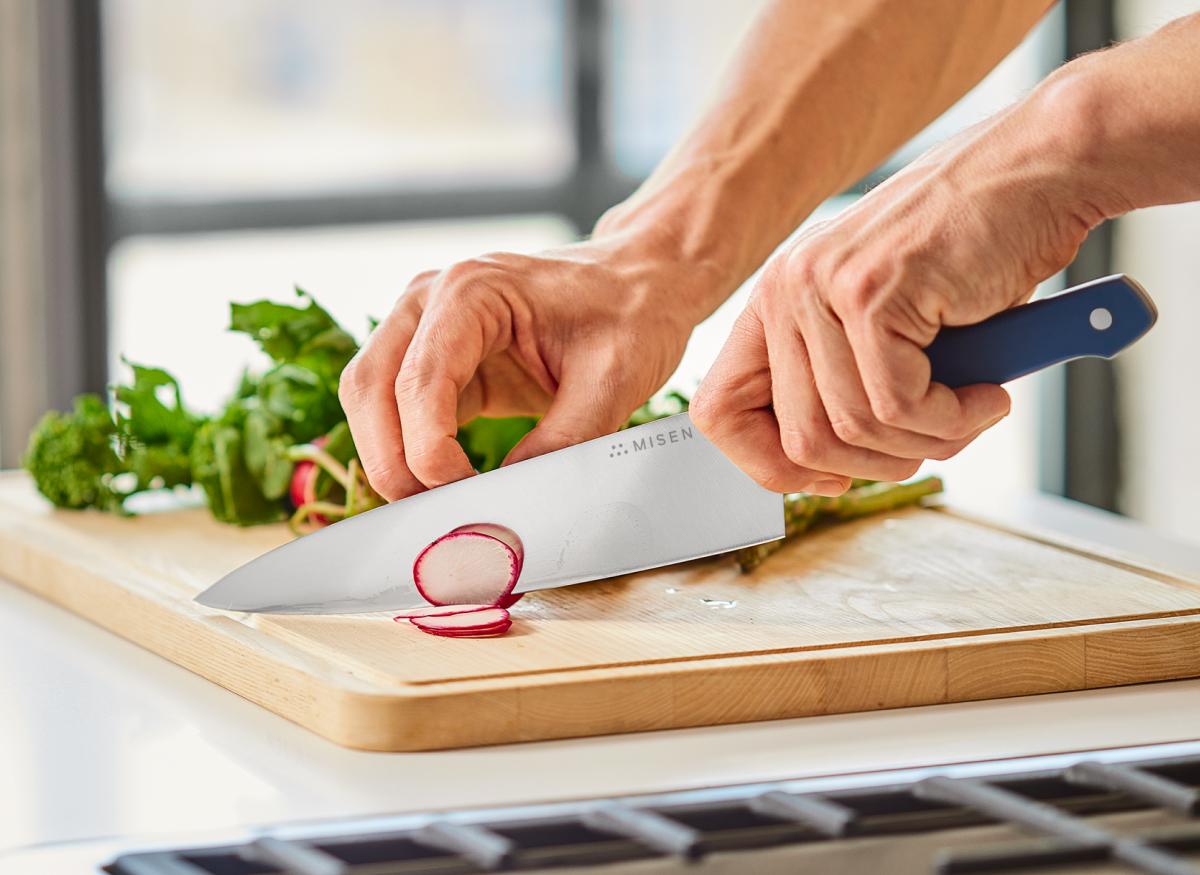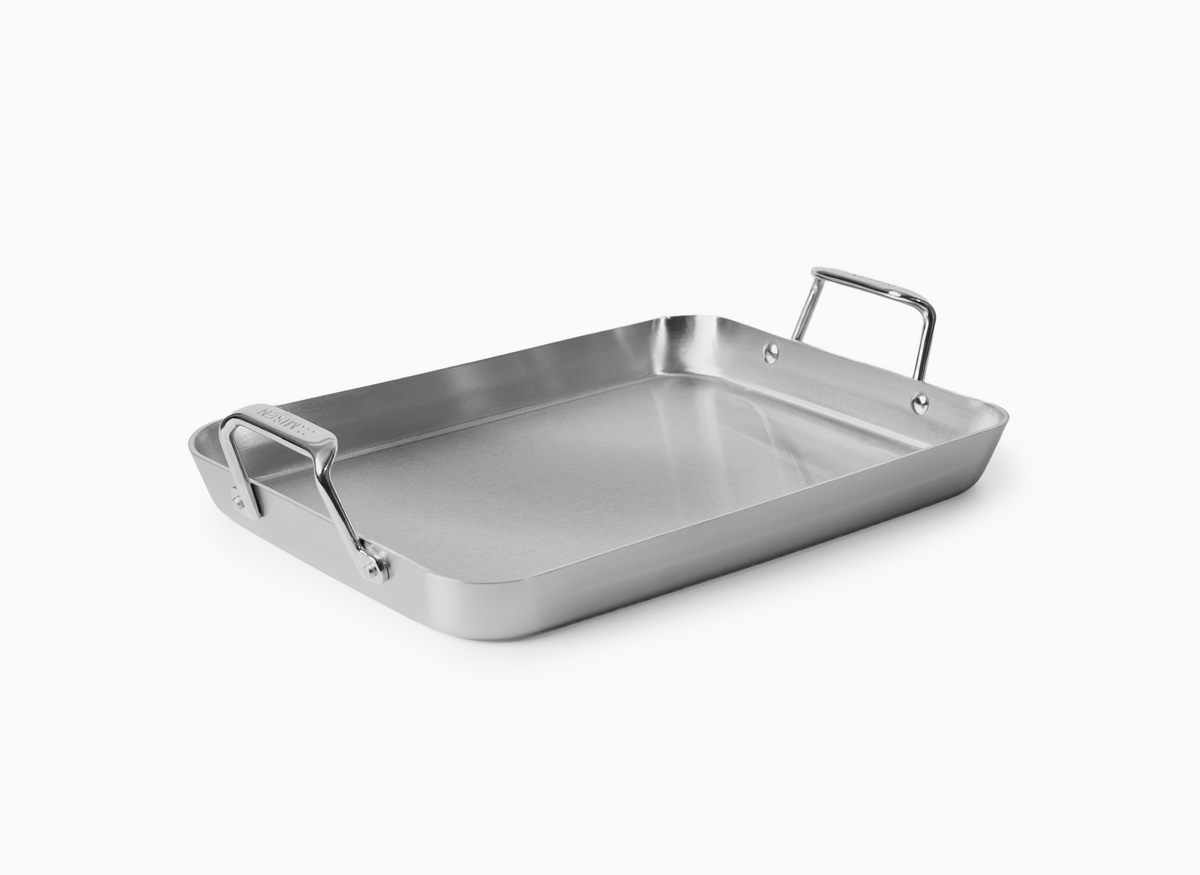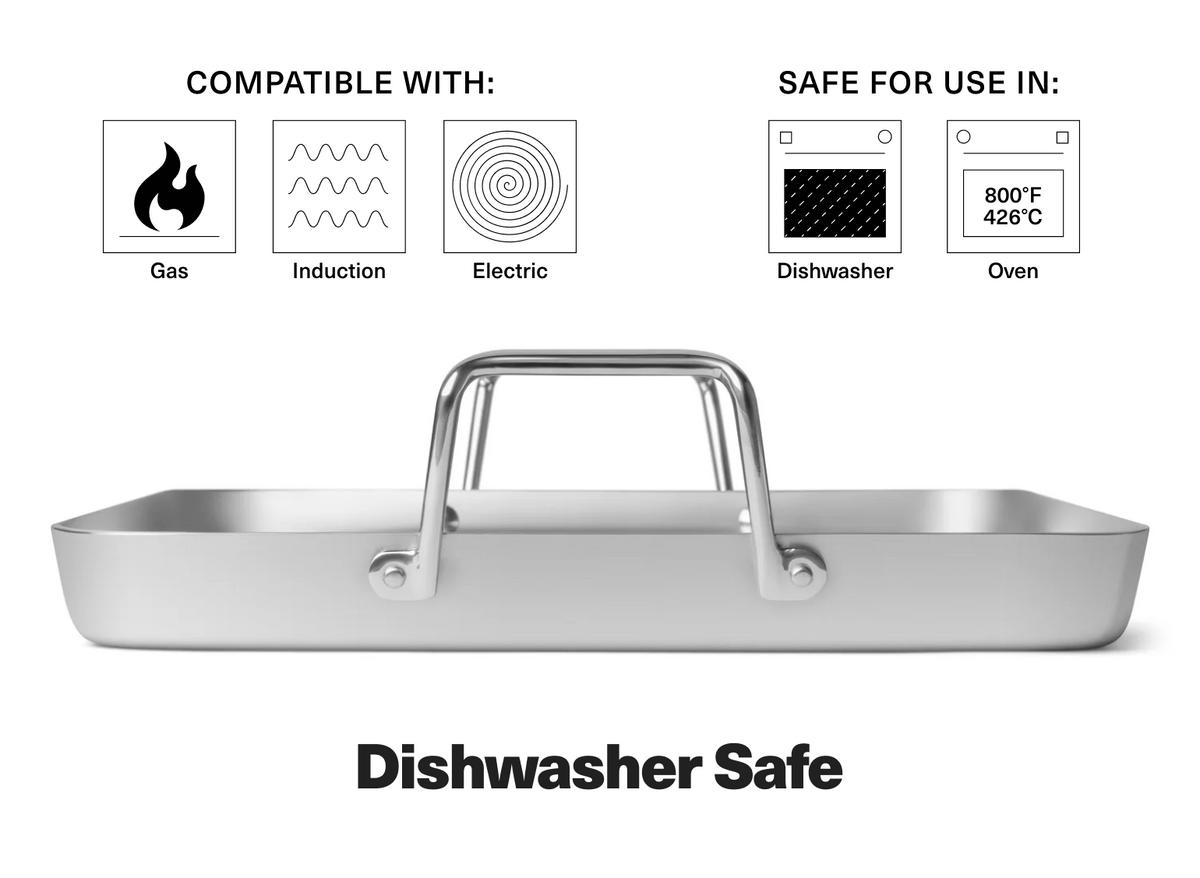Ceramic vs Stainless Steel Cookware: The Complete Comparison for Home Chefs
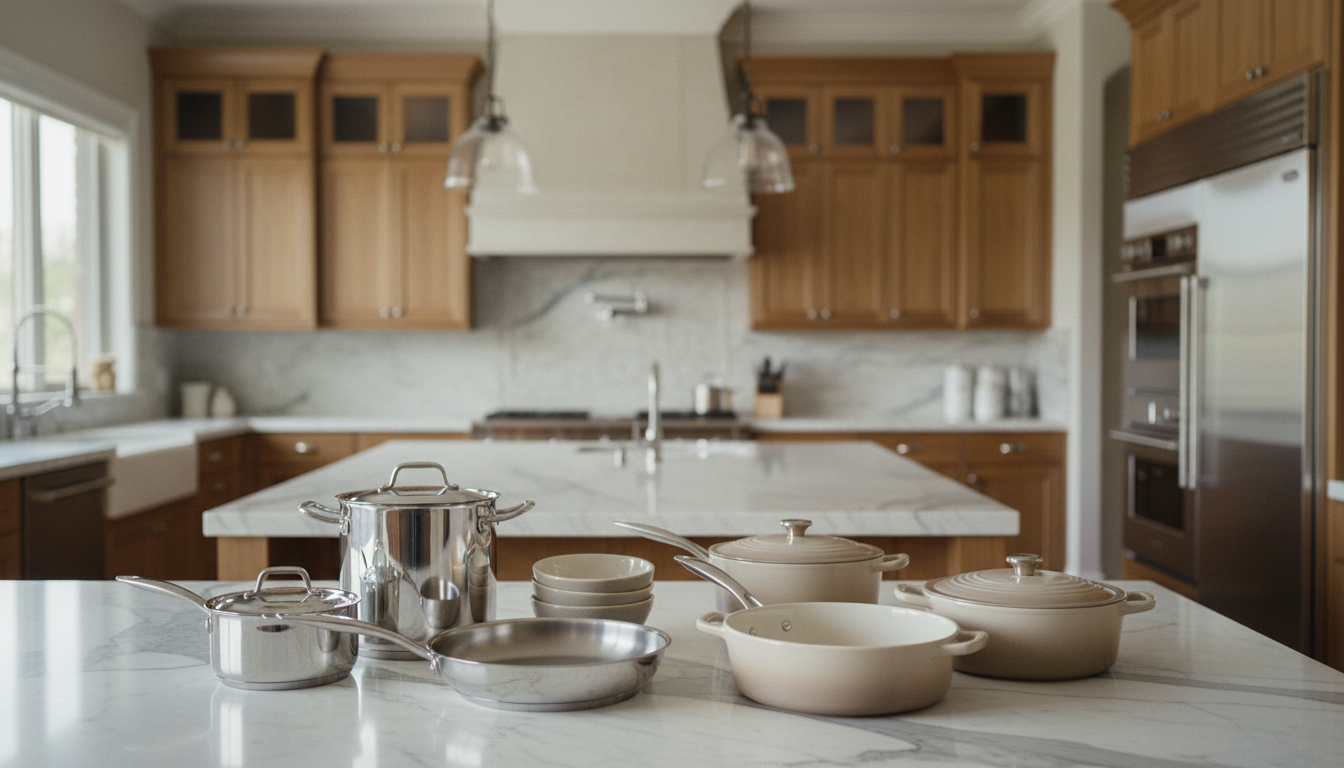
This comprehensive guide equips home chefs to choose between ceramic and stainless-steel cookware by revealing how their materials, construction, and performance translate into real-world cooking experiences. Readers learn that ceramic-coated pans offer effortless, PFAS-free non-stick convenience for eggs and delicate foods at low-to-medium heat but must be replaced every few years, while multi-ply stainless steel demands more technique yet rewards with decades of durability, superior searing, and the fond that creates restaurant-quality pan sauces. The article demystifies heat retention, safety concerns, cleaning protocols, and true long-term costs—showing a $200 stainless pan can cost only $10 per year over decades versus $25 annually for frequently replaced ceramic—so cooks can strategically mix both materials to match their recipes, skill level, and budget. Ultimately, it empowers informed decisions that elevate everyday cooking, minimize environmental waste, and maximize value without compromising health or flavor.
Understanding the Basics of Ceramic vs Stainless Steel Cookware
Understanding that ceramic-coated pans add non-stick silica layers to aluminum while stainless steel builds performance through chromium-rich alloys and copper-aluminum cores fundamentally changes how you choose and use your cookware.
How Each Material Is Made
Ceramic cookware comes in two distinct forms with different manufacturing processes. Pure ceramic cookware is crafted from clay, water, and natural oxides, formed by molding, drying, and firing at extreme temperatures [1]. This creates a non-porous cooking surface without additional coatings.
In contrast, ceramic-coated cookware consists of a metal core (typically aluminum or stainless steel) covered with an inorganic sand-based sol-gel coating derived from silicon dioxide or silica [1]. This provides non-stick properties without PFAS chemicals commonly found in traditional non-stick surfaces [1]. Stainless steel cookware is fabricated from an alloy of iron, chromium, and often nickel [3].
The chromium component forms a protective oxide layer that prevents corrosion and rusting [3]. High-quality stainless steel cookware is frequently manufactured using a "clad" technique, where aluminum or copper is sandwiched between layers of stainless steel [1]. This creates tri-ply (three layers) or five-ply (five layers) construction, combining the durability of stainless steel with the superior heat conductivity of aluminum or copper [1][2].
Core Construction Differences
The fundamental construction of ceramic and stainless steel cookware reveals why they perform differently in your kitchen. Where the manufacturing process creates the basic material, the construction determines how that material performs during cooking. Ceramic-coated cookware (the type most home cooks use) enhances its aluminum core with specialized coatings for non-stick properties [4]. Some manufacturers reinforce these coatings with materials like diamond particles for added durability [4].
The aluminum base provides even heating, while brands focusing on versatility add steel plates to ensure induction compatibility [4]. Stainless steel cookware builds performance through smart engineering. Quality pans use 18/10 steel (18% chromium, 10% nickel) for lasting durability and corrosion resistance [5]. Since steel alone doesn't conduct heat efficiently, manufacturers solve this by sandwiching aluminum or copper between steel layers—a process called cladding [6].
This creates cookware with 3, 5, or even 7 layers working together [4]. You'll find two main designs: fully-clad (metal layers throughout) or disc-bottom (layers only at the base).
Typical Price Ranges
Understanding price differences helps you make smarter cookware investments. Ceramic cookware offers an accessible entry point at $15-$30 per piece, with complete sets ranging from $50-$200 depending on features and coatings [7].
Stainless steel requires a higher initial investment—expect to pay $20-$50 for basic pieces and $100-$300 for quality tri-ply or five-ply sets [7]. The key consideration isn't just upfront cost but value over time.
Since ceramic cookware typically needs replacement every 2-5 years while stainless steel can last decades, that seemingly expensive stainless pan often costs less per year of use [8]. For detailed pricing comparisons and budget-friendly recommendations, see our "Cost-Effectiveness for Everyday Home Chefs" section below.
Performance in the Kitchen
Choose stainless steel for the blazing sear and fond-driven sauces that ceramic’s gentle, non-stick surface simply can’t deliver.
Heat Conductivity and Temperature Control
Heat performance directly affects your cooking results. Ceramic cookware distributes heat evenly, making it reliable for consistent cooking temperatures [10]. However, test results vary on heat retention—some sources report good heat holding [10], while others find ceramic loses temperature faster than stainless steel [9].
Pure stainless steel conducts heat poorly, which is why quality cookware sandwiches aluminum or copper between steel layers [9][10]. This multi-ply construction creates responsive temperature control essential for precision cooking [9]. The superior heat capacity allows stainless steel to maintain high temperatures needed for proper searing and browning [10].
For recipes requiring quick temperature changes—like deglazing after searing—stainless steel responds faster. Ceramic excels when you need steady, gentle heat without hot spots.
Searing, Browning & Sautéing
For high-heat searing and browning, stainless steel delivers superior results. Its heat retention keeps the pan hot when cold meat hits the surface—essential for the Maillard reaction that creates flavorful crusts [4]. Don't worry when food initially sticks to stainless steel.
This temporary adhesion creates the direct contact needed for proper browning. Once a crust forms, food releases naturally [4]. This sticking also produces fond—those caramelized bits that build incredible flavor in pan sauces.
Ceramic's slick surface prevents this flavor development [4]. Testing proves the heat retention difference: water stays hotter significantly longer in stainless steel versus ceramic pans after removing from heat [4]. While you can sear in ceramic cookware, you won't achieve the same deep caramelization or crispy texture [9].
Non‑Stick Food Release
Ceramic excels at preventing food from sticking. Its smooth, non-stick surface lets you cook with minimal oil—perfect for eggs, pancakes, and delicate fish that typically cling to pans [4][9]. Food slides effortlessly across ceramic coating, and you get this convenience without PFAS chemicals [9]. Stainless steel requires technique to prevent sticking.
Without proper preheating and oil, food bonds to the surface [4]. But here's the key: this "sticking" serves a purpose. The direct contact develops better browning and creates fond—those flavorful bits that transform into amazing pan sauces [4]. Master the technique: preheat your stainless pan, add oil at the right moment (just before smoke point), then let food sear undisturbed.
It releases naturally once properly browned [4]. Yes, stainless steel demands more skill, but the payoff is superior flavor development that non-stick surfaces simply can't deliver [11].
Best‑Fit Cooking Techniques
Match your cookware to your cooking method for best results. Stainless steel handles the demanding, high-heat techniques: searing steaks, browning vegetables, and building pan sauces through deglazing [12]. Multi-ply construction with aluminum or copper cores provides the precise temperature control you need when transitioning from sear to simmer [12]. Plus, stainless steel moves seamlessly from stovetop to oven for braising and roasting [12].
Ceramic shines with gentler cooking methods. Use it for scrambling eggs, cooking fish fillets, or making pancakes—foods that need low to medium heat and easy release [12]. Its even heat distribution prevents hot spots when simmering sauces or soups [12]. Just remember: high heat damages ceramic's coating and performance [12].
Smart cooks keep both types on hand. Reach for stainless steel when you want maximum flavor through browning and fond development. Choose ceramic for delicate foods and healthy, low-oil cooking [12].
Durability, Maintenance & Longevity
Choose stainless steel for dishwasher-tough, steel-wool-safe durability, or baby ceramic with baking-soda pastes and soft cloths to keep its non-stick surface alive and out of the landfill.
Wear Resistance and Expected Lifespan
When it comes to durability, ceramic and stainless steel cookware couldn't be more different—and that difference affects your wallet over time.
Stainless steel shines here, thanks to its chromium content that fights rust and corrosion [13].
Cleaning Best Practices
The way you clean your pans directly affects how long they'll last. Ceramic needs kid-glove treatment—steel wool or metal scrubbers will destroy that non-stick surface permanently [14]. For everyday cleaning, warm soapy water and a soft cloth do the job perfectly. Got stubborn food stuck on?
Try these ceramic-friendly solutions: - **Baking soda paste**: Mix baking soda, hydrogen peroxide, and a few drops of dish soap. Let it sit for 30 minutes, then rinse [14] - **Vinegar soak**: Mix 1 part vinegar with 4 parts water. Either soak for a few hours or bring to a quick boil [15] - **The ketchup trick**: Spread 2 tablespoons over greasy spots, leave overnight, rinse with lukewarm water [14] Stainless steel is much more forgiving. Yes, it's dishwasher-safe, but hand-washing keeps that shine longer [15].
For serious stuck-on messes, boil one tablespoon cream of tartar with a cup of water right in the pan, let it cool, then scrub away [15]. Unlike ceramic, you can safely use steel wool on stainless steel when you need serious scrubbing power [14].
Caring for Your Cookware to Reduce Waste
Want to keep your cookware out of landfills? A little extra care goes a long way. For ceramic pans, stick with soft cleaning tools—those metal scourers you're eyeing will wreck the coating faster than you can say "non-stick" [16]. When tough residue strikes, reach for a homemade paste of baking soda, hydrogen peroxide, and dish soap instead of harsh chemicals [16]. Stainless steel might be dishwasher-safe, but hand-washing keeps it looking new much longer [16]. Got burned-on food?
Here's a pro tip: boil a tablespoon of cream of tartar with water right in the pan. No scraping needed—the gunk lifts right off [16]. **Storage matters too:** - Stack ceramic pans with cloth or paper dividers between them - Even tiny scratches speed up coating breakdown [17] - Hang pans when possible to avoid contact damage The environmental impact of replacing cookware is bigger than most people realize. Those damaged non-stick coatings? They'll sit in landfills for centuries [17]. Plus, manufacturing new pans uses massive amounts of energy and resources [17].
**Temperature tips for longevity:** - Let pans cool naturally before washing (no cold water shock! ) - Keep ceramic below manufacturer's max temp - These simple habits prevent warping and coating damage [18] Making your cookware last isn't just about saving money—though that's a nice bonus. It's about reducing waste and doing your part for the planet. A well-maintained pan that lasts decades beats a drawer full of damaged cookware any day.
Health, Safety & Environmental Impact
Your non-stick pan could be dosing your dinner with forever chemicals and heavy metals, while switching to stainless steel eliminates the toxins and actually builds better flavor through the Maillard reaction.
Coating Safety and Chemical Concerns
Let's talk about what's actually going into your food when you cook. Traditional nonstick pans with PTFE coatings (think Teflon) have raised red flags because they contained PFOA, a "forever chemical" that builds up in your body [19]. Heat these pans above 570°F and they start breaking down, releasing compounds you definitely don't want in your dinner [21]. Even pans claiming to be "PFOA-free" can still contain traces of these chemicals, according to Consumer Reports testing [19].
Ceramic-coated pans seem like the safer choice, and they do test free of the 96 PFAS chemicals commonly screened for [19]. But here's the catch: these aren't traditional ceramics. They're made using a lower-temperature process that might include organic polymers and metal oxide nanoparticles like titanium dioxide, which can end up in your food [21]. There's another concern many home cooks overlook: heavy metal contamination.
The FDA warns that some imported aluminum and brass cookware can leach dangerous levels of lead into food during cooking [20]. Even small amounts of lead exposure pose serious risks, especially for pregnant women and young children [20]. This is where quality stainless steel cookware shines. Since it doesn't rely on any synthetic coatings or polymers, there's nothing to break down or flake off into your food.
Metal Reactivity and Food Flavor
Here's something many home cooks don't realize: your cookware actually affects how your food tastes. Stainless steel cookware blends iron, chromium, and nickel into an alloy that won't react with your ingredients [9]. This means no metallic tang in your tomato sauce or weird flavors in your citrus marinades [23]. But stainless steel does something even better—it helps build flavor. When food temporarily sticks to the surface, it triggers the Maillard reaction, creating those delicious brown bits (called fond) that make restaurant-quality pan sauces possible [9]. That's not a cooking mistake; it's flavor development in action.
Ceramic cookware takes a completely different approach. It's 100% non-reactive, so nothing—not even highly acidic foods—will cause it to release metals or chemicals [22]. This makes ceramic perfect when you want pure, clean flavors in delicate dishes. The tradeoff? That same non-stick surface that prevents reactivity also prevents the browning and caramelization that builds complex flavors [9]. Other materials bring their own quirks to the table.
Unlined copper and aluminum can react with acidic foods, potentially adding metallic notes nobody wants. Cast iron actually releases small amounts of iron into food—which can slightly affect taste but also provides a nutritional boost [23]. The bottom line: if you're cooking delicate foods or acidic dishes where pure flavor matters most, ceramic delivers. But when you want to develop rich, complex flavors through proper browning and fond development, stainless steel gives you the tools to cook like a pro [22].
Sustainability of Materials
When we talk sustainability, both ceramic and stainless steel cookware beat traditional nonstick by avoiding PFAS "forever chemicals" that stick around in the environment (and your bloodstream) for generations [24]. Pure ceramic scores points for using natural materials [13], but here's where it gets complicated: ceramic-coated pans are marketed as eco-friendly, yet they typically need replacing every 2-5 years [24]. That's a lot of pans heading to landfills. Stainless steel takes a different approach to sustainability.
Yes, manufacturing metal cookware requires more resources upfront, but when a pan lasts 20+ years instead of 2-5, that environmental cost gets spread over decades of daily use [24]. Think of it this way: one quality stainless steel pan could outlast 5-10 ceramic-coated ones. Want to make the most sustainable choice? Focus on longevity over marketing claims [13].
Whether you choose pure ceramic or stainless steel, buying quality pays off environmentally. And here's how to make any pan last longer: - Keep metal utensils away from ceramic surfaces - Let hot pans cool before washing (thermal shock is real) - Actually read those temperature guidelines—they're there for a reason [24] These simple care steps can double or triple your cookware's lifespan, which is the most sustainable choice you can make in the kitchen.
Cost‑Effectiveness for Everyday Home Chefs
Spend $200 once on stainless-steel tri-ply and cook for 20 years at $10 a year, or keep buying $50 ceramic pans every two years and pay $25 a year—your wallet decides.
Initial Investment vs Long‑Term Value
The price gap between ceramic and stainless steel cookware reflects their fundamentally different value propositions. You'll find ceramic nonstick skillets starting at $30-$100, while quality stainless steel sets require $200-$1,000+ upfront [5]. This significant price difference becomes more nuanced when you consider long-term costs.
As discussed in our durability section, ceramic pans need replacement every 1-3 years [6]. Let's break down what this means for your budget: a $200 stainless steel pan used for 20 years costs just $10 annually, while replacing a $50 ceramic pan every two years costs $25 annually [5]. This longevity difference shows up clearly in warranties—stainless steel often comes with lifetime coverage, while ceramic-coated options typically offer just 1-5 years [5].
If you're working with a tight budget, ceramic's lower entry price gets you cooking immediately. But for pieces you'll use daily—like your main sauté pan or saucepan—stainless steel delivers better value over time [6]. Consider ceramic for specialized items you'll use less frequently, like a dedicated egg pan.
Budget‑Friendly Options Without Compromise
Quality cookware doesn't require emptying your wallet. You can find excellent stainless steel sets around $200 that include everything you need: frying pans, saucepans, sauté pans, and stockpots. Look for features like measurement markings inside pots and comfortable handles—these small details make a big difference in daily cooking [25].
When shopping for budget tri-ply stainless steel under $250, prioritize even heat distribution and proper heat retention. Many affordable sets now include larger 10- and 12-inch skillets, which are practical for family meals [27]. While budget options may heat more slowly than premium brands, they often retain heat just as well—a worthwhile tradeoff for most home cooking [27].
For those seeking value-focused performance, consider budget-friendly tri-ply sets from established cookware brands that offer good warranties and consistent performance.
When to Upgrade or Replace
Recognizing when to replace cookware directly impacts both your cooking results and budget. As we covered in the durability section, ceramic cookware typically needs replacement every 2-3 years, while stainless steel can last decades [28]. Watch for these replacement indicators: For ceramic pans, functional decline matters more than visible damage. When food starts sticking despite proper oiling and temperature control, it's time to replace—even if the pan looks fine [28].
Many home cooks find themselves replacing ceramic cookware after just one year of regular use [4]. The coating degrades from high heat, metal utensils, and dishwasher cleaning [4]. Stainless steel rarely needs replacement. Only consider it when you notice warping, deep pitting, or hot spots where heat no longer distributes evenly [9].
These issues indicate core damage that affects cooking performance [4]. To maximize your cookware investment: - Use wood or silicone utensils with ceramic [28] - Let all pans cool naturally before cleaning to prevent thermal shock [4] - Calculate true costs: that $50 ceramic pan replaced every two years costs $25 annually, while a $200 stainless steel pan lasting 20+ years costs just $10 annually [28] The smartest approach? Build a hybrid collection. Use ceramic for eggs and delicate foods where non-stick matters most, and invest in quality stainless steel for everything else [9].
Making the Right Choice for Your Kitchen
Choose ceramic for effortless eggs and fish, stainless steel for steak-worthy sears and pan sauces—owning both lets you cook every meal at its best without compromise.
Matching Cookware to Your Cooking Style
Let's talk about matching cookware to how you actually cook. If your mornings revolve around eggs, pancakes, and delicate fish fillets, ceramic's non-stick surface is your best friend—everything slides right off with minimal oil [9]. It's also great for quick stir-fries where you want even heating and easy cleanup. But here's the thing: if you love getting a good sear on steaks or building flavor through pan sauces, stainless steel is where the magic happens. As we covered in the Performance section, stainless steel creates those delicious brown bits (fond) that take your cooking to the next level [9].
Plus, you can move it straight from stovetop to oven without thinking twice. Smart home cooks often keep both types on hand. Use ceramic for your morning scrambled eggs and delicate fish, then reach for stainless steel when it's time to sear that perfect steak or build a pan sauce [9]. This gives you the best of both worlds without compromise. Think about how often you cook too.
Weekend warriors might prefer ceramic's user-friendly nature, while daily cooks will appreciate stainless steel's durability and professional results—even if it takes a bit of practice. The key is choosing based on what you actually make, not what's trending on social media. If you're concerned about chemicals, ceramic provides peace of mind, while those chasing restaurant-quality results will love stainless steel's responsiveness [9].
Quick Comparison Chart
This chart provides a direct side-by-side comparison of ceramic and stainless steel cookware across key factors: | Feature | Ceramic Cookware | Stainless Steel Cookware | |---------|-----------------|------------------------| | **Construction** | Typically aluminum base with silicon dioxide coating; pure ceramic versions also available [4] | Multiple metal layers (typically 3-5 ply) with stainless exterior and aluminum/copper core [4] | | **Non-stick Properties** | Naturally non-stick without PFAS chemicals, but performance deteriorates over time [4] | Food sticks without proper technique; temporary sticking necessary for proper searing [4] | | **Heat Performance** | Even heat distribution; less heat retention than stainless steel [4] | Superior heat retention; maintains temperature when cold food added [4] | | **Durability** | Typically lasts 1-3 years with regular use [4] | Can last decades or even a lifetime with proper care [29] | | **Best Cooking Uses** | Low to medium heat cooking; eggs, pancakes, delicate foods [4] | High-heat searing, browning, fond development; versatile for all techniques [4] | | **Maintenance** | Requires soft utensils (wood/silicone); no metal tools or abrasive cleaners [29] | Can withstand metal utensils; more forgiving cleaning methods [29] | | **Temperature Limits** | Generally lower oven-safe temperatures; never broiler safe [4] | Can transition between stovetop, oven, and broiler safely [4] | | **Cooktop Compatibility** | Limited induction compatibility unless specifically designed with steel plate [4] | Works on all cooktops including induction [4] | | **Weight** | Typically lighter due to aluminum construction [4] | Heavier due to multiple metal layers [4] | | **Price Range** | Lower initial cost but requires replacement every few years [4] | Higher initial investment but better long-term value [4] | | **Aesthetic Options** | Available in various colors and finishes [29] | Classic, timeless appearance with polished or brushed finish [29] | | **Health Considerations** | No PTFE or PFOA chemicals; considered safer for chemical-conscious cooks [13] | Non-reactive surface with no coating to chip or flake into food [29] |
Practical Buying Guide Checklist
Your Pre-Purchase Checklist
Here's what to consider before adding new cookware to your kitchen: **Cooking Style Check** What do you cook most? Ceramic handles eggs and fish beautifully, while stainless steel nails high-heat searing and browning [30]. **Heat Requirements** Know your limits—ceramic prefers low to medium heat, while stainless steel can handle the high temperatures needed for proper searing [1]. **Utensil Inventory** Got metal utensils? Stick with stainless steel. Ceramic needs gentle treatment with wood, silicone, or bamboo tools [30]. **Cleaning Reality** Be honest about cleanup.
Ceramic releases food easily for quick washing, while stainless steel sometimes needs extra elbow grease for stuck bits [31]. **Cooktop Compatibility** Using induction? Check that ceramic pans have magnetic bases, or test stainless steel with a magnet—if it sticks, you're good to go [31]. **Long-Term Budget** Think beyond today's price tag. Ceramic costs less upfront but needs replacing every few years. Quality stainless steel costs more initially but lasts decades [30]. **Kitchen Ergonomics** Consider weight—ceramic is lighter and easier to maneuver, while stainless steel's heft requires more muscle [31].
**Storage Solutions** Limited cabinet space? Ceramic needs protective dividers when stacked, while stainless steel is more forgiving [30]. **Health Priorities** Both materials avoid harmful chemicals—ceramic skips PFAS entirely, while stainless steel has no coatings to worry about [1]. **Flavor Goals** Want restaurant-quality results? Stainless steel's fond development creates complex flavors that non-stick surfaces can't match [1].
- Stainless steel lasts decades, ceramic-coated pans need replacing every 2-5 years.
- Stainless steel excels at high-heat searing; ceramic is best for low-oil, delicate foods.
- Ceramic avoids PFAS chemicals but may contain nanoparticles; stainless steel is coating-free.
- Use wood/silicone tools on ceramic to prevent coating damage; stainless tolerates metal utensils.
- Ceramic costs $15–30 per piece upfront; stainless steel averages $20–50 but lasts far longer.
- Let pans cool before washing to prevent warping and extend any cookware’s lifespan.
- Hybrid kitchens benefit: ceramic for eggs/fish, stainless for steaks and pan sauces.
- https://www.organicauthority.com/guide/stainless-steel-vs-ceramic-cookware
- https://en.stainlesseurope.com/en_US/n/113
- https://allniceofficial.com/ceramic-or-stainless-steel-cookware/
- https://prudentreviews.com/ceramic-vs-stainless-steel-cookware/
- https://www.solamexhome.com/ceramic-vs-stainless-steel-cookware-health-durability-cooking-performance-compared.html
- https://en.pfluon.com/ceramic-vs-stainless-steel-cookware-6-key-differences-explained-2
- https://kitchensupports.com/ceramic-vs-stainless-steel-cookware/
- https://www.360cookware.com/blogs/360-cookware-blog/stainless-steel-vs-ceramic-cookware?srsltid=AfmBOopDcCO-MUM_69w8Qr6ghnSnt3Mm7LpTTtiCAgyMEoR1StFWcIuu
- https://chopchopusa.com/blogs/news/ceramic-vs-stainless-steel-cookware
- https://thankfullylocalchef.com/blog/ceramic-vs--stainless-steel-cookware--a-comprehensive-comparison
- https://razab.com/blogs/kitchen-tips/ceramic-vs-stainless-steel-cookware?srsltid=AfmBOooxJeP6IDVU5urklL4fgCsMW-_f686Fct9ZNkeUyA2XQh8lQHbp
- https://www.cupindy.com/blogs/info/cooking-pans-materials-guide?srsltid=AfmBOoo-0NBZPWWYhkdJ9BUBsI_vTtgfh6pl3Xdqr0--qCvvxsblkO07
- https://en.pfluon.com/ceramic-vs-stainless-steel-cookware-6-key-differences-explained
- https://www.dalstrong.co.uk/blogs/chef-blog/ceramic-cookware-vs-stainless-steel-cookware-what-s-your-pick
- https://www.whirlpool.com/blog/kitchen/how-to-clean-pots-and-pans.html
- https://thegoodlifedesigns.com/ceramic-vs-stainless-steel-cookware/
- https://www.cuminco.com/blogs/our-blog/sustainability-in-your-kitchen-why-durable-cookware-is-the-future?srsltid=AfmBOorYi1E1LHK2_UetJQiGJ87vmPVI4f8_qsKql-kgYRxajrwbE1xu
- https://nest-wellness.com/blog/healthy-cookware-and-food-storage/
- https://www.consumerreports.org/toxic-chemicals-substances/you-cant-always-trust-claims-on-non-toxic-cookware-a4849321487/
- https://www.nbcnews.com/select/shopping/fda-warning-nonstick-cookware-leaching-lead-rcna231938
- https://ceramics.org/ceramic-tech-today/ceramic-coated-cookware-safety/
- https://www.cupindy.com/blogs/info/cooking-pans-materials-guide?srsltid=AfmBOor7MgJTm3CknLRIHnQS2wNb6CffxsPF76AJLZhYpsLS936bCqmc
- https://www.yahoo.com/lifestyle/stainless-steel-vs-ceramic-cookware-192213447.html
- https://www.nbcnews.com/select/shopping/best-budget-cookware-sets-rcna123456
- https://www.nytimes.com/wirecutter/reviews/best-cookware-set/
- https://www.milkglasshome.com/stainless-steel-vs-ceramic-cookware/
- https://www.360cookware.com/blogs/360-cookware-blog/stainless-steel-vs-ceramic-cookware?srsltid=AfmBOoq2hwx3qBcDRdKwCyxzCy9Prm1qMlmNNBRS2KPYVEG_CQnBn8Bq
- https://www.360cookware.com/blogs/360-cookware-blog/stainless-steel-vs-ceramic-cookware?srsltid=AfmBOopTaOnrKLcBCzNPCVZKqxRfoml4UNxB6kRgcp8mKPDkb1K23lxZ
- https://greenpan.com.au/blogs/greenpan-blog/non-stick-ceramic-cookware-vs-stainless-steel?srsltid=AfmBOopV6h74Kzt8tdQppeixcASOqghHVuV7vOGC78fA0RHhsWv6hZ91
